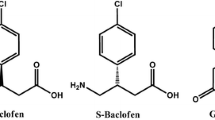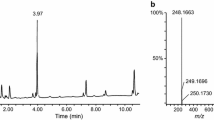Abstract
Diphenidine [1-(1,2-diphenyl-ethyl)piperidine] in the tissue sections of the adipose, brain, heart, kidney, and liver obtained from a human cadaver in a poisoning case was directly analyzed as the first trial by matrix-assisted laser desorption ionization (MALDI)-quadrupole time-of-flight mass spectrometry (QTOF-MS). The frozen tissue block of approximately 5 × 5 × 5 mm3 was sectioned to a thickness of 10 or 20 μm at −20 or −35 °C. For quantitation, the reference standard solutions of diphenidine were placed at 0, 0.1, 1, and 10 ng/well on the wells of a MALDI sample plate firstly, and about 20 tissue sections (ca. 5 × 5 mm2 each) were placed on the sample plate secondly, followed by detection by MALDI-MS/MS after desiccation of the tissue sections and spraying α-cyano-4-hydroxycinnamic acid as the matrix. The quantitation was performed by the standard addition method without the use of blank human tissues. The correlation coefficients between the concentrations of diphenidine and the relative signal intensities were from 0.937 to 0.994 for five kinds of tissue. The suppression of signals by tissue was increased in the order of adipose tissue < brain < heart, kidney, and liver; hence, the adipose tissue was most suitable tissue among them for the detection of diphenidine. In the present method, the concentration linearity and repeatability were not satisfactory for quantitative analysis, but allowable for semiquantitation. Therefore, the present method can be used for a semiquantitative analysis of diphenidine in tissue sections because of the simplicity of the method.




Similar content being viewed by others
References
Hasegawa K, Wurita A, Minakata K, Gonmori K, Nozawa H, Yamagishi I, Watanabe K, Suzuki O (2015) Postmortem distribution of AB-CHMINACA, 5-fluoro-AMB and diphenidine in body fluids and solid tissues in a fatal poisoning case: usefulness of the adipose tissue for detection of drugs in the unchanged forms. Forensic Toxicol 33:45–53
Minakata K, Yamagishi I, Nozawa H, Hasegawa K, Wurita A, Gonmori K, Suzuki M, Watanabe K, Suzuki O (2015) Diphenidine and its metabolites in blood and urine analyzed by MALDI-Q-TOF mass spectrometry. Forensic Toxicol 33:402–408
Reyzer ML, Hsieh Y, Ng K, Korfmacher WA, Caprioli RM (2003) Direct analysis of drug candidates in tissues by matrix-assisted laser desorption/ionization mass spectrometry. J Mass Spectrom 38:1081–1092
Wang HYJ, Jackson SN, McEuen J, Woods AS (2005) Localization and analyses of small drug melecules in rat brain tissue sections. Anal Chem 77:6682–6686
Hsieh Y, Casale R, Fukuda E, Chen J, Knemeyer I, Wingate J, Morrison R, Korfmacher W (2006) Matrix-assisted laser desorption/ionization imaging mass spectrometry for direct measurement of clozapine in rat brain tissue. Rapid Commun Mass Spectrom 20:965–972
Kuwayama K, Tsujikawa K, Miyaguchi H, Kanamori T, Iwata YT, Inoue H (2011) Distribution measurement of amphetamine-type stimulants in organs using micropulverized extraction and liquid chromatography/tandem mass spectrometry to complement drug distribution using mass spectrometry imaging. Rapid Commun Mass Spectrom 25:2397–2406
Kuwayama K, Tsujikawa K, Miyaguchi H, Kanamori T, Iwata YT, Inoue H (2012) Distribution measurements of 3,4-methylenedioxymethamphetamine and its metabolites in organs by matrix-assisted laser desorption/ionization imaging mass spectrometry using an automatic matrix spraying system with an air brush and a turntable. Anal Bioanal Chem 404:1823–1830
Koeniger SL, Talaty N, Luo Y, Ready D, Voorbach M, Seifert T, Cepa S, Fagerland JA, Bouska J, Buck W, Johnson RW, Spanton S (2011) A quantitation method for mass spectrometry imaging. Rapid Commun Mass Spectrom 25:503–510
Landgraf RR, Garrett TJ, Prieto Conaway MC, Calcutt NA, Stacpoole PW, Yost RA (2011) Considerations for quantification of lipids in nerve tissue using MALDI mass spectrometric imaging. Rapid Commun Mass Spectrom 25:3178–3184
Wurita A, Hasegawa K, Minakata K, Gonmori K, Nozawa H, Yamagishi I, Suzuki O, Watanabe K (2014) Postmortem distribution of α-pyrrolidinobutiophenone in body fluids and solid tissues of a human cadaver. Leg Med 16:241–246
Acknowledgments
This work was supported by a Grant-in-Aid for Scientific Research (Number 2560867) from the Ministry of Education, Science, Sports and Culture of Japan.
Author information
Authors and Affiliations
Corresponding author
Ethics declarations
Conflict of interest
There are no financial or other relations that could lead to a conflict of interest.
Ethical approval
This article does not contain any studies with living human participants or animals performed by any of the authors. The analysis of toxic substances from the cadaver was permitted by judicial authorities with an official document.
Rights and permissions
About this article
Cite this article
Minakata, K., Yamagishi, I., Nozawa, H. et al. Semiquantitation of diphenidine in tissue sections obtained from a human cadaver in a poisoning case by direct MALDI-QTOF mass spectrometry. Forensic Toxicol 34, 151–157 (2016). https://doi.org/10.1007/s11419-015-0300-y
Received:
Accepted:
Published:
Issue Date:
DOI: https://doi.org/10.1007/s11419-015-0300-y




